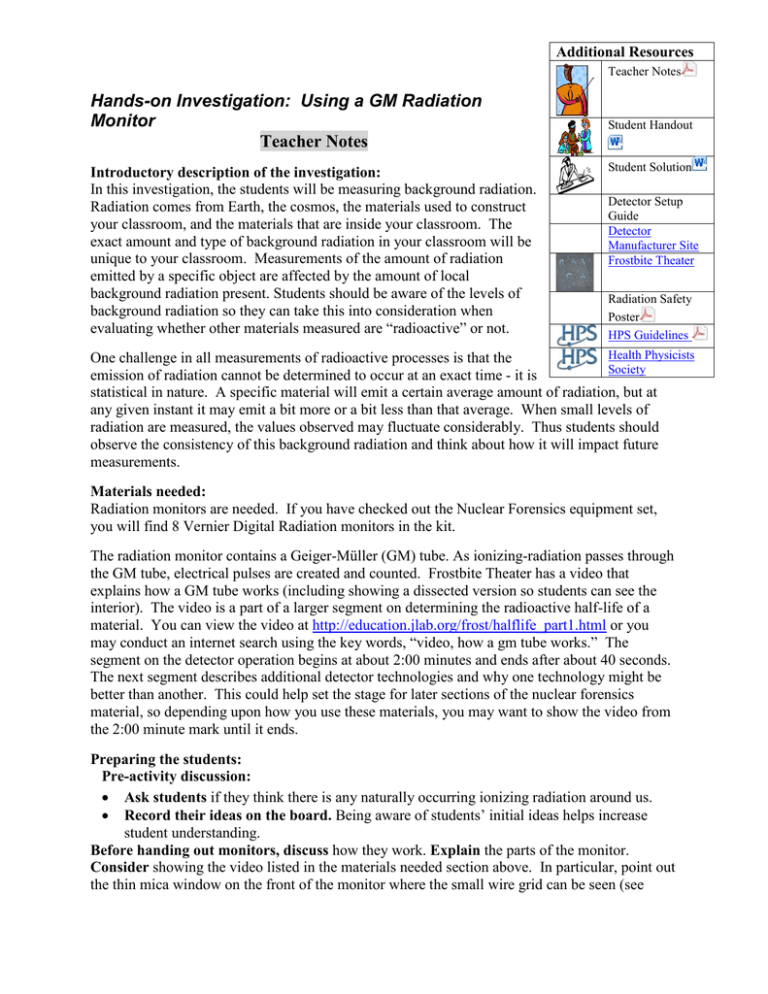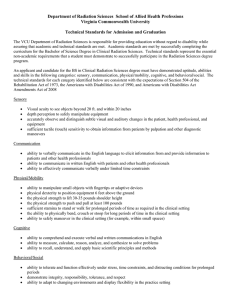Hands-on Investigation: Using a GM Radiation Monitor Teacher Notes
advertisement

Additional Resources Teacher Notes Hands-on Investigation: Using a GM Radiation Monitor Teacher Notes Introductory description of the investigation: In this investigation, the students will be measuring background radiation. Radiation comes from Earth, the cosmos, the materials used to construct your classroom, and the materials that are inside your classroom. The exact amount and type of background radiation in your classroom will be unique to your classroom. Measurements of the amount of radiation emitted by a specific object are affected by the amount of local background radiation present. Students should be aware of the levels of background radiation so they can take this into consideration when evaluating whether other materials measured are “radioactive” or not. Student Handout Student Solution Detector Setup Guide Detector Manufacturer Site Frostbite Theater Radiation Safety Poster HPS Guidelines Health Physicists One challenge in all measurements of radioactive processes is that the Society emission of radiation cannot be determined to occur at an exact time - it is statistical in nature. A specific material will emit a certain average amount of radiation, but at any given instant it may emit a bit more or a bit less than that average. When small levels of radiation are measured, the values observed may fluctuate considerably. Thus students should observe the consistency of this background radiation and think about how it will impact future measurements. Materials needed: Radiation monitors are needed. If you have checked out the Nuclear Forensics equipment set, you will find 8 Vernier Digital Radiation monitors in the kit. The radiation monitor contains a Geiger-Müller (GM) tube. As ionizing-radiation passes through the GM tube, electrical pulses are created and counted. Frostbite Theater has a video that explains how a GM tube works (including showing a dissected version so students can see the interior). The video is a part of a larger segment on determining the radioactive half-life of a material. You can view the video at http://education.jlab.org/frost/halflife_part1.html or you may conduct an internet search using the key words, “video, how a gm tube works.” The segment on the detector operation begins at about 2:00 minutes and ends after about 40 seconds. The next segment describes additional detector technologies and why one technology might be better than another. This could help set the stage for later sections of the nuclear forensics material, so depending upon how you use these materials, you may want to show the video from the 2:00 minute mark until it ends. Preparing the students: Pre-activity discussion: • Ask students if they think there is any naturally occurring ionizing radiation around us. • Record their ideas on the board. Being aware of students’ initial ideas helps increase student understanding. Before handing out monitors, discuss how they work. Explain the parts of the monitor. Consider showing the video listed in the materials needed section above. In particular, point out the thin mica window on the front of the monitor where the small wire grid can be seen (see Figure 1). Emphasize that this mica window is VERY fragile and that they should not only avoid poking it, but they should simply not let anything touch that part of the monitor. Consider setting a minimum distance to place objects in front of the mica window, mandating no closer than 0.1 cm for any object. If the window is broken, it must be sent back to the manufacturer for repair. The repairs cost over $90. Should a monitor be damaged more extensively (for example, if someone places it in a microwave and turns on the microwave), it will have to be replaced at a cost of $250. If students exercise common sense and use the detectors as directed in the activities in this curriculum, it is unlikely that the detectors will be damaged. Once you have cautioned the students, you should demonstrate how the detectors should be used. Describe the counting modes listed below. In the initial investigations, the students will let the monitor count the number of ionizing radiation particles that the GM tube registers. Total Count Mode: To start, slide the top “Mode” switch downward into the Total/Timer position. Turn the monitor on by sliding the bottom switch upward into the Audio position. When the display reads “TOTAL” and “0” or “1” the monitor will start counting radioactivity. A clicking sound is made every time ionizing radiation is detected by the monitor. The digital counter will also increase each time ionizing radiation is detected. After one minute passes, the counter will make a very loud beep, but will continue to count and click. When they are ready to take another measurement, they can turn the monitor on and off and repeat the process. Timed Count Mode: To start, turn the monitor by sliding the bottom switch upward into the Audio position. Then, slide the top “Mode” switch into the Total/Timer position (if it is already in this position, slide it out and then back in). The display should show an hour glass icon on the left and say “SET” on the top right. The number displayed is the length of time for which it will count. To change the length of time over which they will count, press the “+” button or “-”button on the front face of the monitor (near the Mica window). We suggest counting for between 4 and 6 minutes for samples with low activities. When the students are ready to record data, they should push the “Set” button on the front face of the monitor. The monitor will beep loudly three times. A clicking sound is made every time ionizing radiation is detected by the monitor. The digital counter will also increase each time radiation is detected. After one minute passes, the counter will make a series of very loud beeps and the counter will stop changing. It will, however, continue to click whenever radiation passes through the Geiger tube. When they are ready to take another measurement, they should slide the mode switch out of the Total/Timer position and back in to reset the counter. When they are ready to take measurements, the will push the “Set” button to start the timed count process again. The key objectives for this activity include: • Becoming familiar with operating the radiation monitors • Understanding the fluctuations associated with taking measurements of statistical processes • Understanding some of the factors that affect the variability associated with background radiation Procedure: Distribute the worksheet Measuring Background Radiation Levels in the Classroom to guide students through the key objectives or have students design their own investigation. In either case, students should share their results with the class. The class data should be analyzed and discussed.





